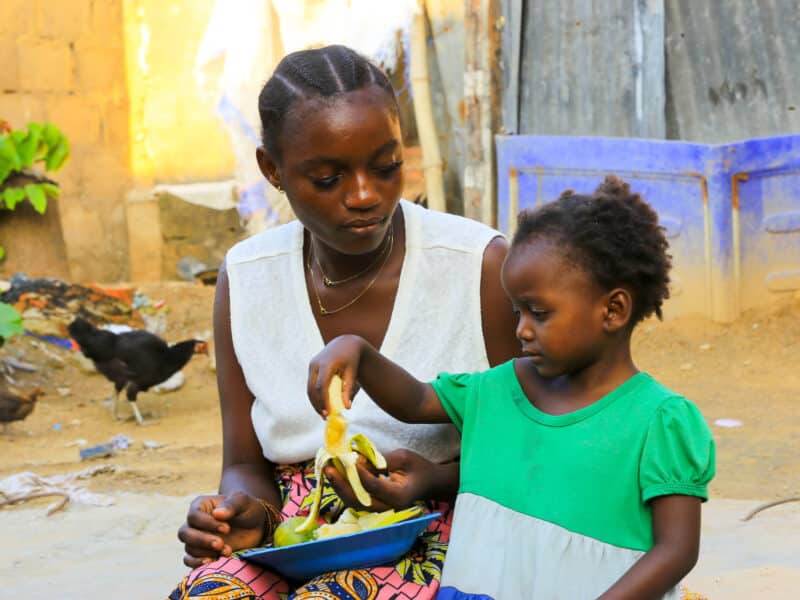Economic downturns in 129 of the world’s low- and middle-income countries due to COVID-19-related lockdowns, border closings and more may have killed hundreds of thousands of children under the age of five in the first year of the pandemic.
The findings, published today in the journal PLOS One, shine light on a hidden COVID-19 death toll – young children who die not from the disease, but from the disruptions in food and medicine deliveries, closed health clinics and delays in childhood immunizations that have resulted from precautions taken to reduce the spread of the virus. Nearly half of the excess deaths of children are estimated to have occurred in sub-Saharan Africa.
“This is a group that is very sensitive to economic shocks and their plight isn’t being discussed,” says Joseph Millward, MHS, a senior research data analyst at the Johns Hopkins Center for Communication Programs and one of the authors of the new study. “Many of the countries in our analysis have relatively young populations with tenuous access to stable housing, clean water, food, and primary care. The health of these children is highly susceptible to reductions in the economic well-being of their families. These are side effects of the pandemic.”
The researchers believe this is the first paper to provide estimates of the mortality impact of COVID-19 on children attributable to economic loss. It was conducted using data from the World Bank World Development Indicators and the United Nations World Populations Prospects.
The model created by the researchers looked at additional deaths in 2020 to be expected in children under 5 with a range of recession rates: a 5 percent, 10 percent and 15 percent reduction in a country’s gross domestic product (GDP). In the most conservative case, a GDP per capita reduction of 5 percent, the researchers estimated that between 279,000 and 286,000 additional lives of children under 5 were lost due to indirect effects of COVID-related recessions in 2020. That translates to an additional 43,000 deaths in India and an extra 22,000 deaths in Nigeria compared to an average year.
At 10 percent and 15 percent, recessions would lead to higher losses of lives in children under 5, increasing to 585,802 and 911,026 additional deaths, respectively.
The economic effects on child health are independent of whether children acquire COVID-19 disease.
“During the lockdowns, many children were not able to be treated for different infectious diseases, receive routine immunizations or attend school,” says study author Marcelo Cardona, MSc, of the ROCKWOOL Foundation in Denmark. “These could have serious socioeconomic consequences not just now but in the short- and long-term, since a child’s development has been put in jeopardy.”
The International Monetary Fund estimates that the global economy shrank by 4.4 percent in 2020 compared with a contraction of just 0.1 percent in 2009, during the financial crisis known as the Great Recession. The economic downturns of 2020 are projected to reverse a sustained trend of decline in global poverty, with an expected 42 to 66 million additional children falling into extreme poverty as a result.
Most of this increased child mortality manifests through adverse effects on diet, environment and health care seeking. One key recommendation calls for policymakers and other actors in public health to not only focus their programs and policies on the direct effects of COVID-19, but also ensure continued investments in food supplementation, growth monitoring and comprehensive primary health care to mitigate further impact on children.
The lack of access to COVID-19 vaccines in LMICs might also contribute to economic downturns in many countries. Nearly 68 percent of Americans are fully vaccinated. But most of Africa missed a World Health Organization target of ensuring 40 percent of people in every country be fully vaccinated by the end of 2021. In December, only about 9 percent of people on the African continent were fully vaccinated against COVID-19.
“A lot of conversations on vaccine equity currently center around mitigating the direct health effects of COVID-19, but vaccine equity stands to affect so much more,” Millward says. “The longer low rates of vaccination persist, the greater the risk is for children’s health to be adversely affected by potential disruptions to economic activity. Ensuring access to vaccines and working with communities and individuals to boost vaccine acceptance and uptake are critical steps to mitigating future direct and indirect effects of the pandemic”.
In line with this, there is evidence pointing out how important trust in government is to engage a community in a public health response that includes vaccine uptake, the authors say. Yet as the pandemic evolved, government trust – on average – has decreased.
“Therefore it is crucial for policymakers to be transparent and communicate with the community to avoid misinformation and further distrust,” Cardona says.
“Estimated impact of the 2020 economic downturn on under-5 mortality for 129 countries” was written by Marcelo Cardona, Joseph Millward, Alison Gemmill, Katelyn Jison Yoo and David M. Bishai.





